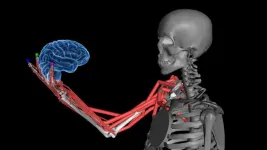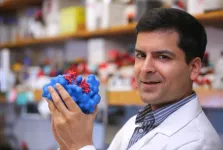Mysterious exporter for brassinosteroid first identified
2024-03-21
(Press-News.org)
When you are reading this article, there are multiple hormones working diligently inside your body to stabilize your health status. Same as human beings, it is impossible for plants to grow and reproduce without being regulated by phytohormones. One of the phytohormones is the Brassinosteroid (BR) hormones, also named as the sixth phytohormone.
According to a study published in Science on March 22, 2024, researchers led by Prof. SUN Linfeng from the Division of Life Sciences and Medicine of the University of Science and Technology of China (USTC), together with Prof. Eugenia Russinova from the VIB-UGent Center for Plant Systems Biology, discovered the first BR exporter and presented its structure in both the substrate-unbound and the brassinosteroid-bound states.
Brassinosteroid (BR) hormones play a key role in regulating plant development and physiology, including adaptation to environmental stresses. They are also widely used in agriculture due to the high economic benefits and impressive effects. Previous studies on BR have clarified their synthesis, metabolism and signaling processes, while the key mechanism by which the synthesized BR inside the cell is exported out to execute its function remains unknown. However, with the first BR exporter recognized in this latest finding, scientists are taking a major step forward.
The newly collaborated BR exporter, ABCB19, used to be commonly recognized as a transporter protein for another crucial phytohormone, auxin. However, the mutant phenotype of ABCB19 does not completely match that of typical auxin transporter proteins. Based on this, the team raised a bold question of whether ABCB19 has substrates other than auxin.
The researchers sought all kinds of evidence to testify their assumption. They first tested the ATPase activities of the Arabidopsis ABCB19 in the presence of different phytohormones including auxins and brassinosteroids. Results show that the ATPase activity of ABCB19 can be stimulated by the bioactive brassinosteroids in a dose-dependent manner, but not by auxins or the brassinosteroid-biosynthesis precursors. Meanwhile, in vitro and in vivo assays were used to evaluate the transport of brassinosteroids by ABCB19.
With the help of cryo-electron microscopy, the researchers were able to witness the process of ABC19 exporting brassinosteroids, as well as to determine the unique architecture of ABC19 which enables it to bind with brassinosteroids.
Furthermore, plant physiological and genetic analyses were performed to confirm the role of ABCB19 in brassinosteroid signaling. All the experimental results point to the conclusion that BR is the substrate of ABC19.
“We were quite puzzled for a while because our experiment results didn’t agree with the common belief that ABC19 is an auxin exporter. But when it turned out that brassinosteroid is also its substrate, we were so thrilled,” said YING Wei, first author of the study. “This is a very unexpected and exciting discovery,” commented one of the reviewers.
“Past research focused more on the cell level, which might be the reason why all these years we overlooked the fact that brassinosteroid is the transport substrate,” explained Prof.SUN Linfeng. This new study elucidated the role of Arabidopsis ABCB19 as brassinosteroid exporter and opened up new ideas for research on the ABC family. “Future research will unravel the mechanisms regulating the ABCB19 activation and substrate preference and hopefully identify additional brassinosteroid exporters. Such mechanisms will help us design more effective strategies to improve plant productivity and resilience via modulating endogenous brassinosteroid amounts and distribution,”said Prof. Eugenia Russinova.
END
ELSE PRESS RELEASES FROM THIS DATE:
2024-03-21
Images
A new way to make an important ingredient for plastics, adhesives, carpet fibers, household cleaners and more from natural gas could reduce manufacturing costs in a post-petroleum economy by millions of dollars, thanks to a new chemical reactor designed by University of Michigan engineers.
The reactor creates propylene, a workhorse chemical that is also used to make a long list of industrial chemicals, including ingredients for nitrile rubber found in automotive hoses and seals as well as blue protective gloves. ...
2024-03-21
How does your brain know the position and movement of your different body parts? The sense is known as proprioception, and it is something like a “sixth sense”, allowing us to move freely without constantly watching our limbs.
Proprioception involves a complex network of sensors embedded in our muscles that relay information about limb position and movement back to our brain. However, little is known about how the brain puts together the different signals it receives from muscles.
A new study led by Alexander Mathis at EPFL now sheds light on the question by exploring how our brains create a cohesive sense of body position and movement. Published in Cell, ...
2024-03-21
Species diversity promotes ecosystem stability
Biodiversity loss may accelerate ecosystem destabilization
What maintains stability within an ecosystem and prevents a single best competitor from displacing other species from a community? Does ecosystem stability depend upon the presence of a wide variety of species, as early ecologists believed, or does diversity do the exact opposite, and lead to instability, as modern theory predicts?
Resolving a long-standing debate among ecologists
A new study from McGill University and ...
2024-03-21
University of Calgary researchers have discovered the lungs communicate directly with the brain when there is an infection. Findings show the brain plays a critical role in triggering the symptoms of sickness, which may change the way we treat respiratory infections and chronic conditions.
“The lungs are using the same sensors and neurons in the pain pathway to let the brain know there’s an infection,” says Dr. Bryan Yipp, MD '05, MSc'05, clinician researcher at the Cumming School of Medicine and ...
2024-03-21
A team led by Dr. Samie Jaffrey, the Greenberg-Starr Professor of Pharmacology at Weill Cornell Medicine, has been awarded a three-year, $1.65 million grant for RNA research under a biotechnology-development program run by the U.S. National Science Foundation.
The competitive Molecular Foundations for Biotechnology program funds cutting-edge research that lays the groundwork for future clinical and industrial biotechnologies. The new award is one of nine that have been given to research teams across the United States this year, with funding assistance from the National Institutes of Health, to advance the promise of RNA-based therapeutics and ...
2024-03-21
NEW YORK, NY / TORONTO, ON – March, 21, 2024 – Artificial intelligence may make it difficult for even the most discerning ears to detect deepfake voices – as recently evidenced in the fake Joe Biden robocall and the bogus Taylor Swift cookware ad on Meta – but scientists at Klick Labs say the best approach might actually come down to using AI to look for what makes us human.
Inspired by their clinical studies using vocal biomarkers to help enhance health outcomes, and their fascination with sci-fi films like “Blade Runner,” the Klick ...
2024-03-21
Although there are many differences between type 1 diabetes and type 2 diabetes, there are also similarities, such as inflammation of the insulin-producing cells. Researchers at Lund University have studied a protein called C3, which plays a central role in the body’s immune system. The protein is secreted from cells and is found in large quantities in the blood. Previous studies by the same researchers have shown that C3 is also present inside cells and plays an important role there. Now, their latest study in PNAS shows that the protein C3 protects insulin-producing cells from damage and death when it is present ...
2024-03-21
1. A NIMS research team has developed the world’s first n-channel diamond MOSFET (metal-oxide-semiconductor field-effect transistor). The developed n-channel diamond MOSFET provides a key step toward CMOS (complementary metal-oxide-semiconductor: one of the most popular technologies in the computer chip) integrated circuits for harsh-environment- applications as well as the development of diamond power electronics.
2. Semiconductor diamond has outstanding physical properties such as ultra wide-bandgap energy of 5.5 eV, high carriers mobilities, ...
2024-03-21
Research Highlights:
A study of nearly 4 million young adults under age 40 in South Korea found that those who had ideal cardiovascular health were nearly two-thirds less likely to develop heart disease, stroke and/or kidney disease during a 12-year follow-up period.
Adults who had low heart health scores at study baseline in 2009-2010 but improved their cardiovascular health thereafter also had a reduced risk of heart disease, stroke or kidney disease compared to people with persistent low heart health scores.
Embargoed until 10:30 a.m. CT/11:30 a.m. ET, Thursday, March 21, 2024
CHICAGO, March 21, 2024 — An ...
2024-03-21
Today, the Chan Zuckerberg Initiative (CZI) announced several key appointments and a new AI residency program to advance the organization’s AI strategy for science, which is focused on building predictive models of healthy and diseased cells. Several AI experts from academia and industry have joined a newly established AI Advisory Group, which will provide guidance to leaders at CZI and across the Chan Zuckerberg Biohub Network as these organizations work to enable AI at scale for nonprofit life science research. In addition, CZI is launching an AI residency program to develop foundational AI/ML models and tools that will enable ...
LAST 30 PRESS RELEASES:
[Press-News.org] Mysterious exporter for brassinosteroid first identified






